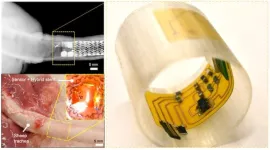(Press-News.org) As mobile-money services were growing at a rapid clip in the developing world 10 years ago, University of Florida computer scientists and cybersecurity experts Kevin Butler and Patrick Traynor were early sentinels, raising concerns about the lack of security that could lead to real problems for the user.
In a 2014 study, the two professors from UF’s Department of Computer and Information Science and Engineering, uncovered security vulnerabilities of mobile cash apps, especially in the Global South, where such technologies were becoming essential in the absence of robust banking systems.
“Our early work uncovered issues of security and privacy when using finance apps,” said Butler, director of the Florida Institute for Cybersecurity Research at UF. “We showed these apps could be hacked, and the consumer has no recourse. We’re often talking about populations where they have very little money to start with, so any type of hack could wipe them out.”
Fast forward to today, Butler and colleagues developed a comprehensive framework for securing mobile money applications that earlier this year was ratified and endorsed by the International Telecommunications Union, a United Nations specialized agency, marking a significant step toward safer digital financial transactions worldwide. All United Nations member states voted to endorse these recommendations.
The framework includes 120 detailed recommendations and controls designed to systematically secure every facet of the financial ecosystem, ensuring comprehensive protection for users and transactions. While the recommendations are non-binding, they are widely followed by telecom providers due to their high quality and the interoperability they provide among networks.
Butler said their work focused on all stakeholders in the digital finance ecosystem, including the user with a smartphone, the phone manufacturer who is responsible for the security of the phone, the cellular networks, base stations, telecommunications providers and third-party regulators.
“We addressed each of the participants and identified what threats they face and the risks, and we provided recommendations for ensuring those risks are mitigated through the system,” Butler said.
Mobile transactions through apps (like those used in the U.S., including PayPal, Zelle and others) are very important to people who don’t have easy access to the banking system. In fact, mobile money transactions account for about 59% of the gross domestic product in Kenya, according to a Forbes report. A similar trend is taking place in South America, Asia and India, Butler said.
Butler and Traynor’s research revealed a variety of vulnerabilities, including with a popular payment app based in India that appeared to use encryption to protect user data but failed to do so securely. They found that the app transmitted sensitive data to its server without encryption, only encrypting it afterward. This lapse in protection could expose users' personal information to potential theft during the unprotected transmission step.
Another app used encryption but relied on a weak key — a fixed series of eight characters followed by the user's phone and account numbers — making it easy for attackers to decode.
“We looked at this from many angles and created the list of recommended controls to thoroughly safeguard all parts of the digital finance network,” Butler said.
With the digital finance security framework complete, Butler said he is working to help deploy the recommendations, meeting with stakeholders in several countries. He recently presented best practices for secure mobile banking systems in Jakarta. He also co-chaired the Security, Infrastructure, and Trust Working Group under the Financial Inclusion Global Initiative, a collaboration involving the United Nations, World Bank, and Bank for International Settlements.
Additionally, the International Telecommunications Union iis conducting security clinics across Sub-Saharan Africa that incorporate many of the document’s recommendations. Clinics have already been held in Uganda, Zambia, Zimbabwe, and Tanzania, aimed at empowering local stakeholders with the knowledge and tools necessary to enhance the security of mobile money applications.
“By fostering collaboration and providing targeted training, the International Telecommunications Union is helping to bolster the resilience of the financial ecosystem in these regions,” Butler said.
END
United Nations ratifies framework to protect people on cash app
2024-11-07
ELSE PRESS RELEASES FROM THIS DATE:
Oklahoma State basketball team joins the Nation of Lifesavers
2024-11-07
http://newsroom.heart.org/news/oklahoma-state-basketball-team-joins-the-nation-of-lifesavers?preview=8409af5e5a5f3127f6aec7e122cc9673STILLWATER, Okla., October 28, 2024 — The Oklahoma State University (OSU) men’s basketball team participated in an American Heart Association Hands-Only CPR (cardiopulmonary resuscitation) training to learn the correct rate and depth of CPR compressions to be confident and capable when faced with a cardiac emergency. Learning Hands-Only CPR is the skill needed to join the Association’s Nation of Lifesavers™ movement, which is focused on doubling survival rates ...
Power of aesthetic species on social media boosts wildlife conservation efforts, say experts
2024-11-07
Facebook and Instagram can boost wildlife conservation efforts through public awareness and engagement, according to a study published in the peer-reviewed journal Environmental Communication.
The findings based on the caracal – a wild cat native to Africa with distinctive tufted ears – demonstrate how social media can harness support for the predators, which some farmers shoot and poison.
Results show that the mammal’s similarity to a domestic feline has attracted thousands of followers to internet feeds about caracal conservation. ...
Researchers develop robotic sensory cilia that monitor internal biomarkers to detect and assess airway diseases
2024-11-07
Xiaoguang Dong, assistant professor of mechanical engineering, is leading a team of researchers that has developed a system of artificial cilia capable of monitoring mucus conditions in human airways to better detect infection, airway obstruction, or the severity of diseases like Cystic Fibrosis (CF), Chronic Obstructive Pulmonary Diseases (COPD) and lung cancer.
The research was published in the November 4 issue of PNAS in the article, “Sensory Artificial Cilia for In Situ Monitoring of Airway Physiological Properties.”
In their paper, the researchers noted that continuously ...
Could crowdsourcing hold the key to early wildfire detection?
2024-11-07
The 2023 blaze in Lahaina, Hawaii, which claimed more than 100 lives and burned 6,500 acres of land across Maui, is a tragic example of how rapid wildfire spread can make effective response efforts impossible, resulting in the loss of life and property.
What if technology could help people detect wildfires earlier? The solution could already be in your pocket: a mobile phone.
USC computer science researchers have developed a new crowdsourcing system that dramatically slashes wildfire mapping time from hours to seconds using a network of low-cost mobile phones mounted on properties in high fire threat areas. In computer simulations, the system, FireLoc, detected blazes igniting ...
Reconstruction of historical seasonal influenza patterns and individual lifetime infection histories in humans based on antibody profiles
2024-11-07
Reconstruction of historical seasonal influenza patterns and individual lifetime infection histories in humans based on antibody profiles
#####
In your coverage, please use this URL to provide access to the freely available paper in PLOS Biology: http://journals.plos.org/plosbiology/article?id=10.1371/journal.pbio.3002864
Article Title: Reconstructed influenza A/H3N2 infection histories reveal variation in incidence and antibody dynamics over the life course
Author Countries: United Kingdom, China, United States
Funding: see manuscript END ...
New study traces impact of COVID-19 pandemic on global movement and evolution of seasonal flu
2024-11-07
UNDER EMBARGO UNTIL 19:00 GMT / 14:00 US EASTERN TIME THURSDAY 7 NOVEMBER 2024
Increased capabilities for genomic surveillance have offered new insights into global viral evolution;
Seasonal flu showed a ‘remarkable’ bounce back to pre-pandemic levels once international air travel resumed;
Regions with fewer COVID-19 restrictions were associated with sustained flu virus transmission.
Seasonal influenza epidemics impose substantial burdens on healthcare systems and cause >5 million hospitalizations of adults each year. The current approach to influenza vaccine development requires comprehensive surveillance ...
Presenting a Janus channel of membranes for complete oil-and-water separation
2024-11-07
Named after the two-faced Roman god Janus to reflect its dual-purpose design, researchers present a novel membrane system – a Janus channel of membranes (JCM) – capable of simultaneously separating oil and water from complex emulsions. The system addresses a critical challenge for sustainable water and oil reclamation across various industries. Separating oil and water from complex mixtures is essential for many scientific and industrial applications, such as wastewater treatment and biological sorting. Membrane ...
COVID-19 restrictions altered global dispersal of influenza viruses
2024-11-07
Although travel restrictions and social measures during the COVID-19 pandemic led to a dramatic global drop in seasonal influenza cases, certain influenza lineages in specific regions kept the virus circulating and evolving, according to a new study. This was true in tropical areas with fewer travel restrictions, for example, including South and West Asia. The spread of seasonal influenza is closely tied to social behavior, particularly air travel, and to the periodic evolution of new virus strains that evade immunity from prior infections or vaccinations. In 2020, nonpharmaceutical interventions (NPIs) introduced to combat COVID-19 – such as ...
Disconnecting hepatic vagus nerve restores balance to liver and brain circadian clocks, reducing overeating in mice
2024-11-07
Disruptions between the brain’s master circadian clock and the liver’s internal clock, communicated via the hepatic afferent vagal nerve (HVAN), can lead to unhealthy eating patterns and increased weight gain, according to a new study in mice. The findings identify the neural link as a potential therapeutic target for obesity and metabolic dysfunction related to circadian disruption. In mammals, circadian rhythms are controlled by the suprachiasmatic nucleus (SCN) – a small part of the brain’s hypothalamus that regulates the body’s circadian rhythms. This cycle triggers a feedback loop involving key clock genes that keep ...
Mechanosensory origins of “wet dog shakes” – a tactic used by many hairy mammals – uncovered in mice
2024-11-07
“Wet dog shakes” – a common reflex behavior shared among many hairy mammals and designed to expel water and irritants from their coats – happens when particular mechanoreceptors are activated, researchers studying mice report. Many furry mammals engage in rapid body twists known as "wet dog shakes" to effectively remove water from their fur, as well as to eliminate irritants like tangles or parasites, particularly in areas on the neck and back that are largely unreachable by self-grooming or licking. However, despite the commonality of this behavior ...


